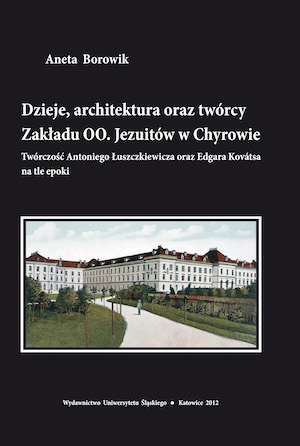Dzieje, architektura oraz twórcy Zakładu OO. Jezuitów w Chyrowie. Twórczość Antoniego Łuszczkiewicza oraz Edgara Kovátsa na tle epoki
The history, architecture and authors of the Institute of Jesuit fathers in Chyrów. Works by Antoni Łuszczkiewicz and Edgar Kováts against a background of the epoch
Author(s): Aneta Borowik
Subject(s): History, Fine Arts / Performing Arts, Architecture
Published by: Wydawnictwo Uniwersytetu Śląskiego
Keywords: architecture; history; historicism; 19th century; Chyrów; Kraków; Galicia; education; pedagogy; Jesuits; Jesuit schooling; Antoni Łuszczkiewicz; Edgar Kovàts; Gottfried Semper
Summary/Abstract: The academic-education centre in Bąkowice near Chyrów is a phenomenon encompassingmany problems. Its 50 years of existence should be considered not onlyat the material level, although it is most interesting for an art historian. Making anattempt to deal with this type of object one cannot forget many issues going beyonda tightly-understood history of art, entering the area of the history of culture, pedagogyand even theology. However, the most primary and leading thought of the bookwas “to save it from being forgotten”, not the phenomenon of Chyrów as such (becauseaccording to the author of the text it is still alive, though it will have to be remindedyounger generations more and more often with time), but a material basethat underwent devastation and disperse. This is an inventorying issue to find,undust and describe each, even the least valuable thing that belonged to the equipmentof the centre or chapel, reconstruct the appearance of the rooms, chapels andbuilding surroundings on the basis of the photography, to bring a former grace ofthis place back at least in this way.The second, equally important aim of this work is to present the object of the19th century architecture which has become a satisfying subject of research formany art historians these days. In the case of the centre in Chyrów, we deal withthe work that is not easy to analyse in a formal-genetic way. Experiencing the objectsof the 19th century art, in the case of which traditionally understood aestheticcategories are not sufficient, we face broader problems that focus the phenomenonof the 19th century as such – its art, philosophy, education, pedagogy, spiritual lifeand, above all, socio-economic problems taking a lead at this time. A presentation ofcentres such as the one in Chyrów also aims at propagating a different perspectiveon the 19th century works of art, and the inclusion of them into the world of valuesand filling the apparently empty crust with a meaning.A broad spectrum of issues raised in the very work was determined by the veryresearch subject, which, as has already been mentioned, is a phenomenon. The authorhad to enter the areas usually unknown to the art. Historians, such as pedagogyin general and Jesuit pedagogy in particular. She also had to, at least in anoutline, present the system of the functioning of the centre and a daily life of its fosterchildren. This way, despite no ambitions to exhaust the topic, the attention thatin the case of a traditional perspective focuses on the work of art, was dispersed.What is more, the obligation required a wider presentation of the profiles of the authorsof the architecture of the centre: Antoni Łuszczkiewicz and Edgar Kováts.The book consists of six parts in general. The first presents the history, organizationand functioning of the academic-education centre of Jesuit fathers in Chyrówcovering the period of almost 50 years of its existence. It also describes a pedagogicsystem used in this institution. The next chapters are devoted to the issues connectedwith an architectural frame of the centre, The history as well as a descriptionof the main building, accompanying buildings and the surroundings as well assculptures and small architecture situated within its scope. Further on, the profilesof and architectural activity of the authors of the material tissue of the centre, i.e.Edgar Kováts, a professor of the Lviv Technical University and the author of the socalled Zakopane measure (sposób zakopiański), and Antoni Łuszczkiewicz,a slightly-forgotten architect from Cracow were presented. Selected realizationswere described and artistic as well as aesthetic attitudes of both architects werepresented. A summary of the parts of the book in question is a chapter devoted tothe academic-education centre of Jesuit fathers in Chyrów as an architectural workof art. It provides a formal-genetic analysis of the team. An important element ofthis publication is appendices including little-known sources presenting the historyof the centre and the history of its authors. These are regulations and rules of thecentre from 1905, a report from the scholarship of the countin Joanna Ledóchowskafoundation made by Antoni Łuszczkiewicz, a list of often very precious and currentlylost books from the centre library, a programme of the very centre from the1880s, an introduction to Sposób zakopański from 1899 by Edgar Kováts and hiscorrespondence concerning the foundation of the Sacred Heart of Jesus Christchurch in Cracow illustrating the archirect’s views on art.When working on the history and architecture of the academic-education centreof Jesuit fathers in Chyrów the source materials from the very epoch and archivematerials derived from among others the collections of the Archive of the MałopolskieProvince of the Association of Jesus, the Archive of the Jagiellonian Universityand the State Archive.
- E-ISBN-13: 978-83-8012-559-9
- Print-ISBN-13: 978-83-226-2108-0
- Page Count: 296
- Publication Year: 2012
- Language: Polish
- eBook-PDF
- Table of Content
- Introduction

